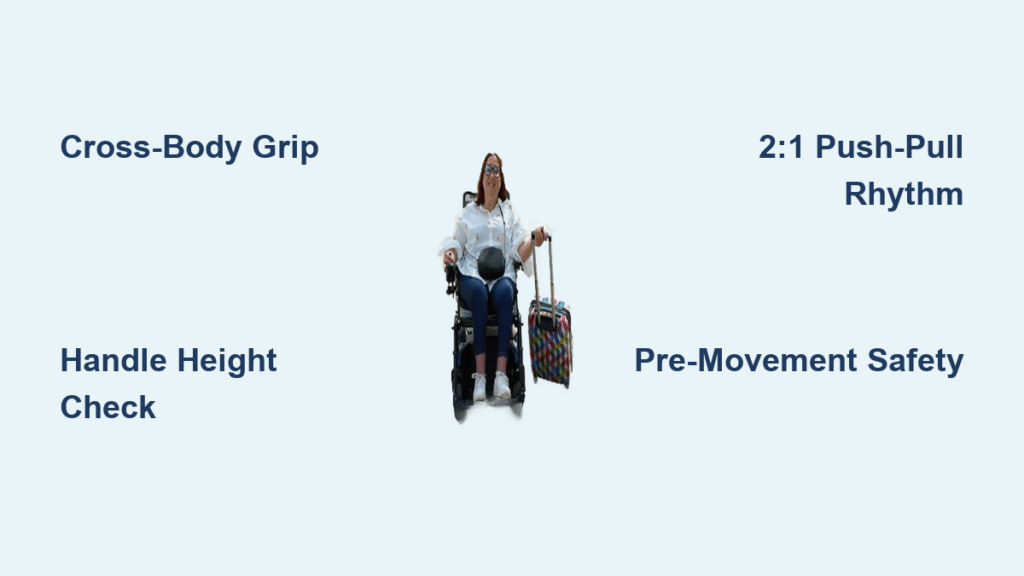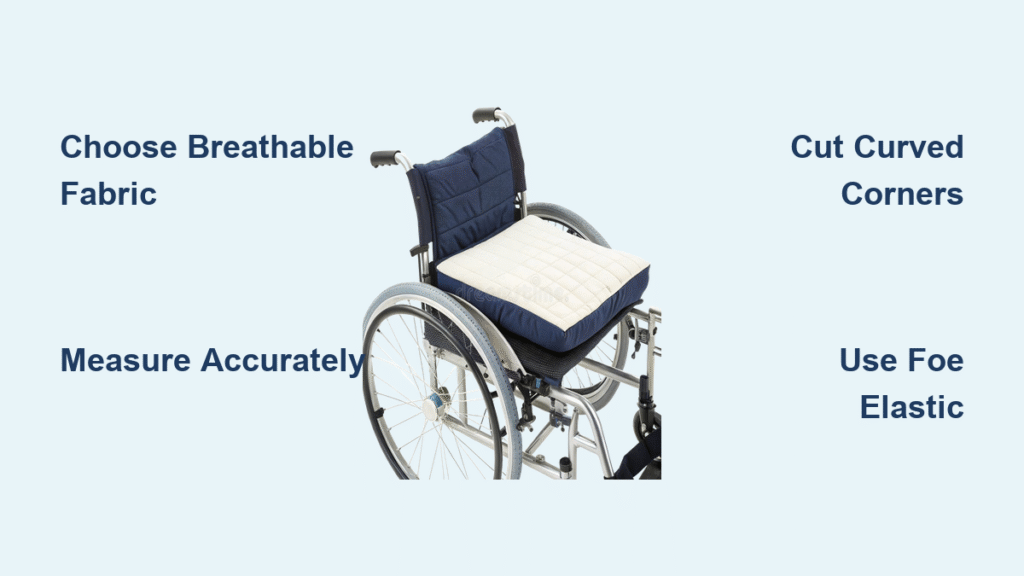That frantic airport dash becomes exponentially harder when you’re simultaneously pushing a wheelchair and pulling a suitcase. Your arms strain in opposite directions, your posture crumbles, and simple navigation turns into an awkward balancing act that leaves both you and the wheelchair occupant uncomfortable. The physical coordination required to manage both tasks creates a unique challenge that 78% of occasional caregivers struggle with during their first travel experience.
This isn’t just about brute strength—it’s about smart technique, proper equipment, and strategic movement patterns that transform chaos into smooth travel. Whether you’re a family member assisting a relative through airport terminals or a professional caregiver managing luggage during transfers, mastering this dual-task coordination prevents injuries, reduces fatigue, and makes travel significantly less stressful for everyone involved.
You’ll discover precise hand positioning techniques that distribute workload efficiently, equipment modifications that make control effortless, and movement patterns that work whether you’re navigating crowded security lines or uneven city sidewalks. These methods, developed through years of caregiver experience, turn what feels impossible into second nature with proper practice.
Perfect Your Wheelchair Push and Suitcase Pull Hand Positioning
Your hands determine whether this maneuver feels like a struggle or flows smoothly. The cross-body technique—dominant hand controlling the wheelchair while the opposite hand pulls the suitcase—creates natural body alignment that prevents the sideways drift common with same-side configurations. This positioning keeps both items behind your body’s center line, dramatically improving control.
Critical hand placement details most people miss:
– Wheelchair grip: Use an overhand grip with thumbs wrapped securely underneath the handles
– Suitcase grip: Employ an underhand grip with palm facing upward for optimal pulling motion
– Grip switching: Alternate hands every 5-7 minutes to prevent repetitive strain injuries
Stand with feet shoulder-width apart when stationary, shifting to a staggered stance as you begin moving. Maintain an upright posture with shoulders squared—never hunch forward. This military-style posture (but relaxed) prevents the back strain that cripples most beginners within minutes of attempting this dual-task maneuver.
Select and Modify Equipment for Dual-Task Control

Wheelchair handle height makes or breaks your experience. Handles positioned between 36-42 inches from ground level prevent the arm fatigue that shorter caregivers experience. If handles are too low, you’ll hunch over; too high, and you lose leverage. Add ergonomic foam grips to reduce vibration transfer, especially crucial during extended airport transfers where concrete floors amplify hand fatigue.
Suitcase specifications that enable smooth dual control:
– Telescoping handle must extend at least 38-42 inches for comfortable pulling posture
– Rubberized grip width of 4-6 inches prevents hand cramping during extended use
– Four-wheel spinner designs provide superior maneuverability over two-wheel models
– Maximum weight should not exceed 30% of your body weight when fully packed
Ultra-light wheelchairs weighing 15-30 pounds significantly reduce physical strain. Standard models at 35-50 pounds work for short distances but create fatigue during longer transfers. Investing in lighter equipment pays dividends during travel days, especially when combined with proper technique.
Establish a Synchronized Movement Rhythm
Start with the wheelchair to establish momentum before engaging the suitcase. Push the wheelchair forward 6-12 inches first, then begin pulling the suitcase as the wheelchair reaches steady movement. The optimal ratio becomes two wheelchair pushes per one suitcase pull—like a 2:1 breathing pattern during exercise. This rhythm prevents the wobbling that occurs when both items move at the same pace.
Forward movement checklist for smooth navigation:
1. Position wheelchair first, align suitcase behind your dominant hand side
2. Push wheelchair 6-12 inches to establish momentum
3. Begin suitcase pull as wheelchair stabilizes
4. Maintain 2-3 mph walking pace on smooth surfaces
5. Reduce speed by 50% on uneven terrain
Turning requires minimum 3-foot radius for the combined turning circle. Always announce turns verbally (“turning left in 3 seconds”) so the wheelchair occupant can anticipate movement. Pivot the wheelchair at the rear axle while allowing the suitcase to follow a wider arc—trying to force both through the same path creates resistance and frustration.
Execute Pre-Movement Safety Checks That Prevent Accidents
Pre-movement safety prevents 90% of accidents during dual-task travel. Always check wheelchair tire pressure (35-50 PSI depending on type) and verify brake functionality before attempting to move both items. Test the suitcase handle security with a firm wiggle—loose handles fail at the worst possible moments, often when navigating crowded areas.
Path evaluation checklist before moving:
– Scan 20 feet ahead for obstacles and surface changes
– Test surface traction with one foot before proceeding
– Identify curb cuts and ramps before reaching them
– Plan rest stops every 200-300 yards for longer distances
Emergency procedures save situations from disaster. During sudden stops, engage wheelchair brakes first, then stabilize the suitcase. If complete loss of control occurs, release the suitcase grip and focus solely on wheelchair stabilization—your primary responsibility is always the person in the wheelchair.
Navigate Doorways, Elevators, and Ramps Without Mishaps

Master the 45-degree doorway approach technique to avoid common snags. Position the wheelchair at a 45-degree angle to the doorway, enter first, then swing the suitcase in a smooth arc behind you. This prevents the suitcase from catching on door frames—a frequent frustration in older buildings with narrow doorways.
Elevator positioning strategy that maximizes space:
– Wheelchair faces forward, centered in available space
– Suitcase positioned beside or directly behind the wheelchair
– Allow extra time for others to exit before entering
– Stand near control panel if possible for easy access
Ramp navigation demands specific physics awareness. Always ascend with the wheelchair first while maintaining tension on the suitcase to prevent rollback. On descents, position yourself between the wheelchair and potential downhill momentum, increasing stopping distance by 30% on any slope. Wet conditions require even greater caution—test surface grip first and increase stopping distance by an additional 20%.
Prevent Injury With Targeted Physical Conditioning

Strengthen these specific muscle groups for sustained dual-task performance. Primary movers include deltoids and trapezius for pushing/pulling, with core abdominals providing crucial stability. Secondary support comes from forearm flexors for grip strength and leg muscles for propulsion. Without proper conditioning, most people hit fatigue within 15 minutes.
Daily injury prevention routine:
– 2-3 minutes of arm circles and shoulder rolls before starting
– Switch hand positions every 5-7 minutes during operation
– Stop every 10 minutes for posture readjustment
– Use padded gloves for extended sessions
Plan for 15-20 minutes maximum continuous operation before requiring rest. This timeframe prevents the muscle fatigue that leads to coordination errors and potential accidents. Simple rotator cuff strengthening exercises significantly improve long-term capability for this specific movement pattern.
Handle Airport Security and Outdoor Terrain Like a Pro
Airport navigation requires strategic timing and preparation. Allow 50% additional time for combined mobility through security checkpoints. Separate items before screening, then recombine afterward. Position the wheelchair perpendicular to baggage claim carousels while keeping the suitcase parallel for easy access to your luggage.
Outdoor terrain modifications for different surfaces:
– Gravel paths: Reduce speed by 50%, use wider wheel tracks
– Grass navigation: Lift suitcase wheels slightly, maintain wheelchair momentum
– Wet conditions: Increase stopping distance by 30%, test surface grip first
– Uneven sidewalks: Approach cracks at 90-degree angles, lift suitcase wheels over
Consider using GPS apps with wheelchair accessibility filters to optimize your routes in unfamiliar areas. These tools identify the smoothest pathways, avoiding unnecessary obstacles that complicate your dual-task challenge.
Troubleshoot Emergencies Before They Become Disasters
Recognize these critical warning signs immediately:
– Suitcase wheel wobble indicates loose bolts—tighten immediately
– Wheelchair drift usually stems from uneven tire pressure
– Handle fatigue responds to padded gloves or grip tape application
Emergency repair solutions for common failures:
– Flat wheelchair tire: Use quick-repair sealant for temporary fixes
– Broken suitcase handle: Convert luggage strap into a temporary pull handle
– Wheelchair brake failure: Use feet as drag brakes while seeking immediate repair
– Lost suitcase wheel: Drag on remaining wheels or convert to carry mode
Establish hand signals with the wheelchair occupant for “stop immediately” situations. Verbal communication often gets lost in noisy environments like airports, making non-verbal signals essential for safety.
Maintain Your Equipment and Body for Long-Term Success
Weekly equipment checks prevent mid-journey failures. Monitor wheelchair tire pressure and test brake functionality monthly. Clean suitcase wheels after outdoor use and lubricate telescoping handles quarterly. Replace suitcase wheels after 500 miles of use, wheelchair tires after 1000 miles—both show gradual wear that impacts control.
Physical health maintenance routines:
– Daily shoulder and wrist stretches to maintain flexibility
– Focus strengthening on rotator cuffs and core muscles
– Consider massage therapy for forearms and shoulders after extended use
– Schedule annual medical check-ups for repetitive strain indicators
Master these techniques through practice in low-pressure environments before attempting busy airports or crowded streets. Start with short distances and gradually increase complexity. Within weeks, this coordination becomes second nature, transforming travel challenges into confident navigation that serves both the wheelchair occupant and luggage needs efficiently. The key takeaway: proper preparation with the right equipment, body positioning, and safety protocols creates smooth travel experiences that benefit everyone involved.





